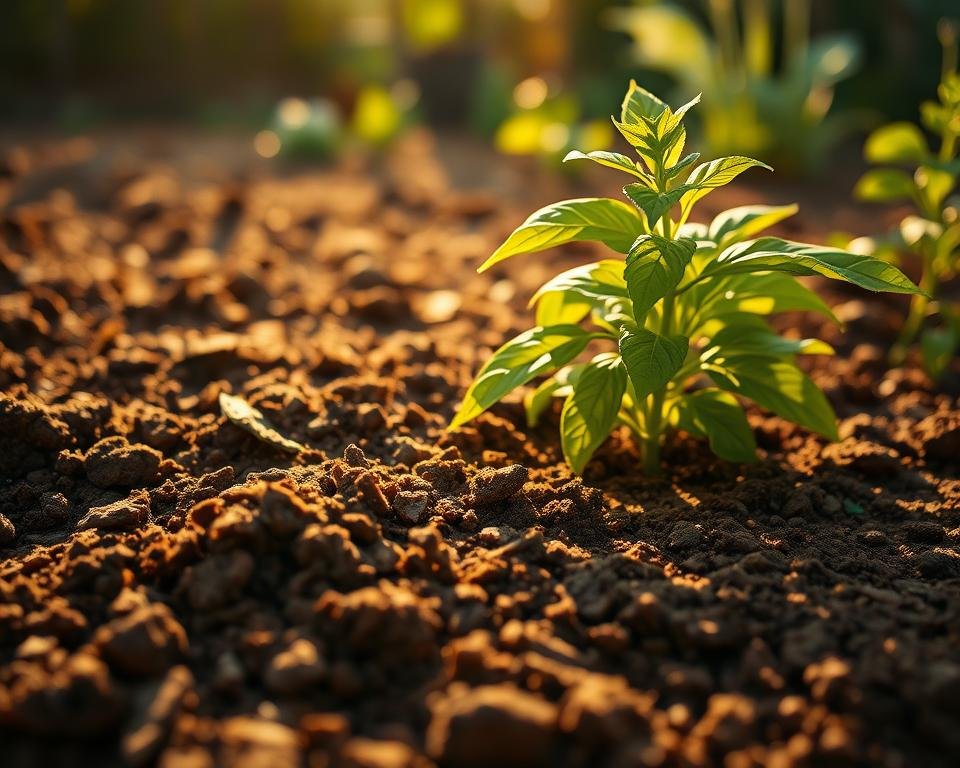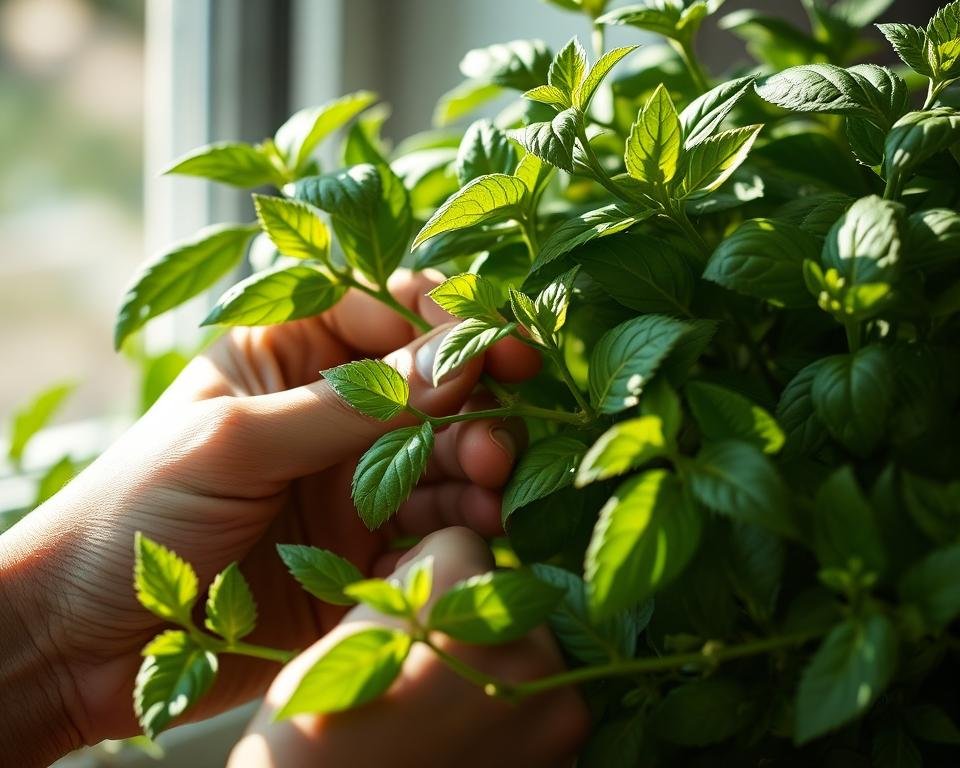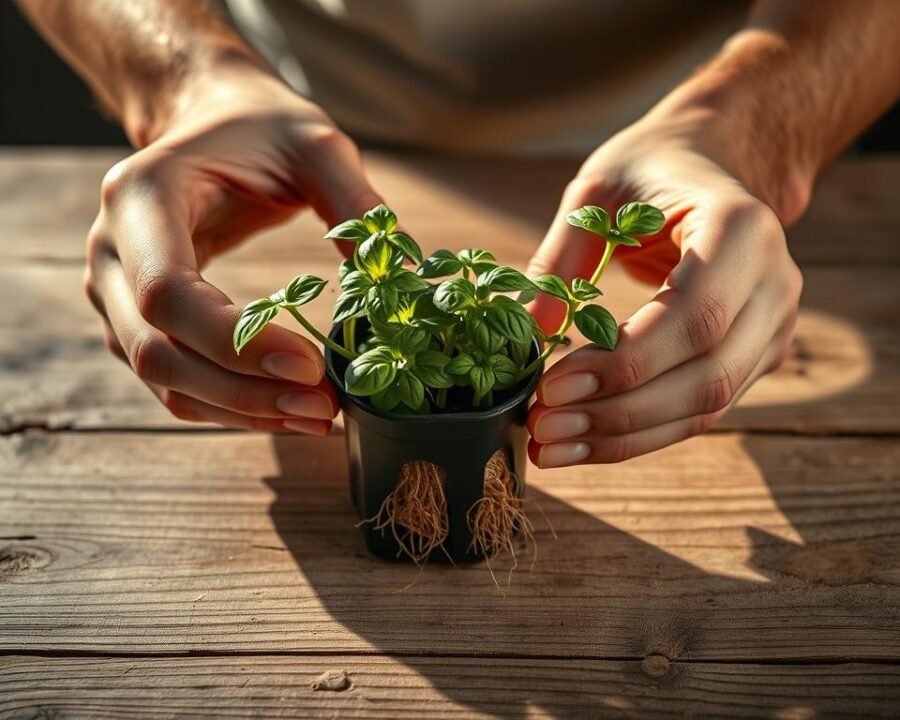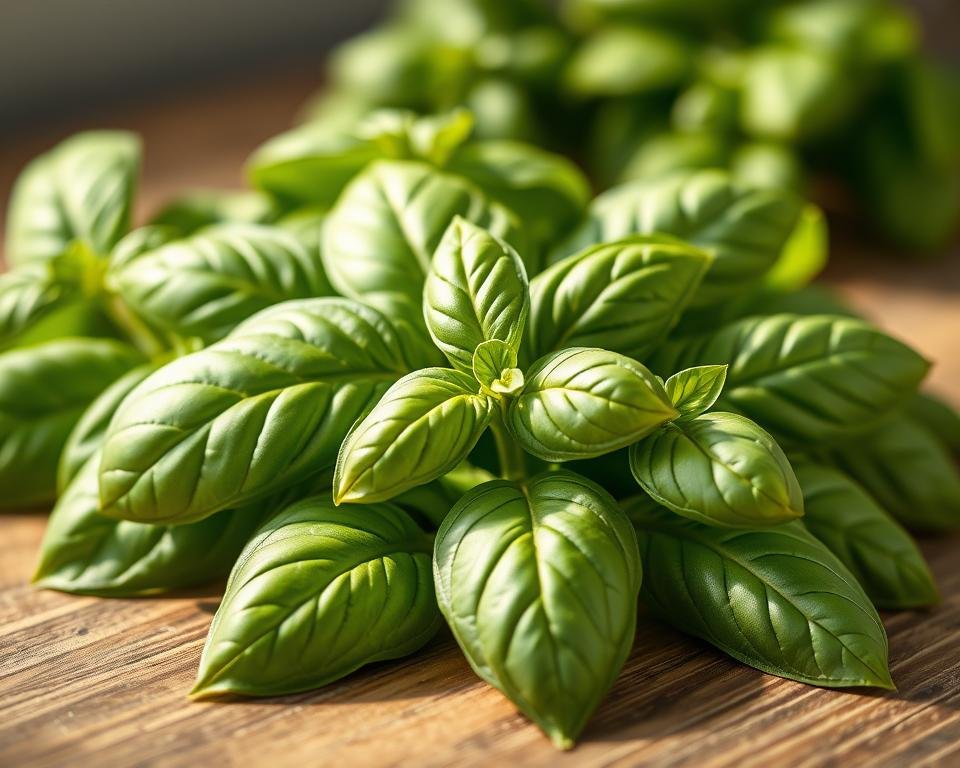There’s something magical about plucking fresh leaves straight from your garden. The aroma alone can transport you to sunlit Italian kitchens or bustling Thai street markets. Basil isn’t just an ingredient—it’s a tiny powerhouse of flavor, transforming meals with its vibrant taste.
Whether tossed into salads, blended into pesto, or garnishing soups, this versatile herb elevates every dish. Best of all? Cultivating it at home is simpler than you might think. With a little care, you can enjoy a steady supply, free from store-bought limitations.
From choosing the right variety to mastering harvest timing, we’ll walk you through each step. Let’s turn your kitchen or backyard into a fragrant oasis.
Key Takeaways
- Basil adds bold flavor to dishes like pesto, salads, and sauces.
- Thrives both indoors and outdoors with proper sunlight and drainage.
- Homegrown options offer fresher taste and no chemical residues.
- Regular pruning encourages bushier, more productive growth.
- Pest management keeps plants healthy without harsh treatments.
Why Grow Basil at Home?
Nothing beats the aroma of freshly picked leaves from your own backyard. Homegrown options offer richer flavor, free from the blandness of store-bought alternatives. Plus, you control the growing conditions—no pesticides, just pure, vibrant taste.
Flavor and Culinary Perks
Fresh basil elevates dishes like no other herb. Toss it into salads, blend it into pesto, or steep it in oils for a fragrant twist. Italian pasta and Thai curries shine with its bold, aromatic notes.
Health Boost in Every Leaf
Beyond taste, these leaves pack antioxidants and anti-inflammatory properties. Studies suggest they may:
- Support immune function
- Reduce stress
- Enhance digestion
Top Varieties to Explore
Choose the right type for your needs. Here’s a quick guide:
| Variety | Best For | Flavor Profile |
|---|---|---|
| Genovese | Classic pesto | Sweet, slightly peppery |
| Thai Basil | Stir-fries | Licorice-like, spicy |
| Purple Rubin | Garnishes | Mild, visually striking |
Pair them with tomatoes or peppers for a thriving garden ecosystem. Just 2-3 plants yield enough for daily use, while 12+ support bulk recipes.
Choosing the Right Basil Variety
Exploring different basil varieties opens doors to unique flavors and garden aesthetics. Whether you crave classic sweetness or exotic spice, there’s a perfect match for every gardener.
Sweet Classics vs. Exotic Stars
Genovese reigns supreme for pesto, while Thai basil adds licorice notes to stir-fries. For visual drama, Purple Rubin or Crimson King deliver deep hues. African Blue dazzles with purple blooms that attract pollinators.
Top Picks for Beginners
New to gardening? Start with Sweet Basil—it’s forgiving and versatile. Greek basil thrives in small spaces, and cinnamon basil offers a spicy twist for adventurous cooks. Avoid holy basil if your area faces cold snaps.
| Variety | Best Use | Special Traits |
|---|---|---|
| Genovese | Pesto, salads | Large leaves, sweet flavor |
| Greek | Container gardens | Tiny leaves, compact growth |
| Cinnamon | Teas, desserts | Warm, spicy aroma |
Pair these plants with tomatoes or peppers for a vibrant garden. Just a few can supply daily needs, while larger plots support bulk harvesting.
How to Grow Basil Herb Plant Everyone is Using
Choosing the right method—seeds or seedlings—sets the stage for success. Each option offers unique perks, whether you value cost savings or instant gratification.
Seeds vs. Seedlings: Which Wins?
Starting from seeds is budget-friendly and rewarding. They sprout in 5–10 days at 70°F, but they need patience. Seedlings, though pricier, let you skip the wait. Here’s a quick breakdown:
- Seeds: Ideal for bulk planting; ~$2 per packet.
- Seedlings: Perfect for beginners; ready to transplant.
Pots and Spacing for Thriving Plants
Give roots room to breathe. In-ground, space plants 12–18″ apart. For containers, pick an 8–12″ pot per plant. Miracle-Gro® Container Mix ensures drainage.
| Planting Method | Spacing | Tips |
|---|---|---|
| In-Ground | 12–18″ apart | Prevents leggy stems. |
| Containers | 1 plant per pot | Use drainage holes. |
Overcrowding risks mold and weak growth. For store-bought plants, harden them off by gradually exposing them to outdoor conditions over 2 weeks.
Preparing the Perfect Soil
Healthy soil is the foundation of a thriving garden. For robust plants, focus on two essentials: pH balance and drainage. Slightly acidic to neutral soil (6.0–7.0 pH) lets roots absorb nutrients efficiently.

Soil pH and Drainage Tips
Test your ground with a kit or digital meter. Too alkaline? Mix in coffee grounds. Clay-heavy? Add perlite or sand to loosen texture. For pots, layer gravel at the base to prevent waterlogging.
Organic Amendments for Rich Soil
Enhance fertility naturally:
- Fold 3 inches of compost into native soil for slow-release nutrients.
- Blood meal boosts nitrogen, fueling leafy growth.
- Avoid unamended clay—it suffocates roots.
With these tweaks, your garden beds or containers will support vibrant flavors all season.
Planting Basil for Success
Timing is everything when starting a fragrant, leafy garden. Wait until two weeks after the last frost to ensure soil temperatures hit at least 50°F. Cold snaps stunt growth, so patience ensures robust plants.
Mastering the Frost Date
Local frost dates vary widely. Use tools like the Old Farmer’s Almanac to pinpoint your ideal planting window. In warmer zones (9–11), afternoon shade prevents scorching.
Sunlight and Location Tips
Basil craves 6–8 hours of daily sun. Indoors, south-facing windows work best. Outdoors, position plants near sun-warmed walls for microclimate benefits. Rotate pots weekly for even exposure.
| Planting Scenario | Ideal Conditions | Pro Tip |
|---|---|---|
| Cool Climates | Post-frost, full sun | Use black mulch to warm soil |
| Hot Summers | Morning sun, afternoon shade | Shade cloth above 90°F |
In peak summer, shield plants during heatwaves. A simple 30% shade cloth preserves moisture without blocking light entirely.
Watering Your Basil Properly
Keeping your plants hydrated is an art—too much or too little can make all the difference. The goal is moist, not soggy, soil. Stick your finger in up to the first knuckle; if it feels dry, it’s time to water.
Finding the Right Rhythm
Container plants need hydration twice as often as in-ground ones. Morning is the best way to water, letting excess moisture evaporate by dusk. Use a narrow-spout can to target the pot’s base, avoiding wet leaves.
Rescuing Overwatered Plants
Soggy soil causes weak stems and yellowing. If roots look brown, sprinkle cinnamon powder—a natural antifungal. For extra humidity, place pots on pebble-filled trays with water.
“Morning watering reduces fungal risks by 40% compared to evening routines.”
Remember: Consistent moisture beats heavy soakings. Adjust frequency during heatwaves, and always prioritize drainage.
Feeding and Fertilizing Basil
Lush, vibrant leaves start with the right nourishment at the right time. While rich soil provides a foundation, strategic feeding ensures robust growth and intense flavor.
Choosing Your Nutrient Boost
Liquid fertilizer like Miracle-Gro® Edibles works wonders every two weeks. For organic options, consider these comparisons:
| Type | Benefits | Best For |
|---|---|---|
| Fish Emulsion | Fast-acting nitrogen | Early season growth |
| Compost Tea | Microbial activity | Soil health |
| Banana Peel Tea | Potassium boost | Flowering stage |
Foliar sprays deliver nutrients directly to leaves for quick absorption. Always dilute to half-strength for young plants.
Timing Is Everything
Begin feeding when stems reach 6 inches tall. During peak growing months, biweekly applications promote bushiness. Stop all fertilizer four weeks before frost to harden plants.
“Overfed basil develops bitter-tasting leaves—moderation enhances flavor.”
Morning applications prevent leaf burn. Pair feedings with deep watering to distribute nutrients evenly.
Pruning and Pinching Techniques
Strategic cuts boost both flavor and foliage density. Proper timing and tools make all the difference between sparse stems and bushy abundance.

Encouraging Bushier Growth
Pinch the top set of leaves when stems reach 4–6 inches tall. This redirects energy to side shoots, creating fuller plants. Always cut at a 45° angle just above leaf nodes—it heals faster.
For clean cuts, use herb scissors instead of fingers. Ragged edges invite disease. Save trimmed stems to propagate new plants in water or seed trays.
| Tool | Best For | Maintenance Tip |
|---|---|---|
| Micro-tip snips | Precision cuts | Wipe blades with alcohol weekly |
| Fiskars shears | Thick stems | Sharpen monthly |
Managing Flowers for Maximum Harvest
Blooming signals reduced leaf production as energy shifts to flowers. For culinary use, pinch buds immediately. Want both? Try this compromise:
- Remove 80% of buds to prolong growth
- Let a few bloom for pollinators
- Dry purple blooms for floral tea blends
“Plants allowed to flower produce 30% fewer leaves but gain enhanced pest resistance.”
With these techniques, your basil plant stays productive all season. Just 5 minutes of time weekly keeps it thriving.
Dealing with Pests and Diseases
Even the most cared-for gardens can attract unwanted visitors. Quick identification and natural solutions keep problems manageable without harsh chemicals.
Handling Common Intruders
Aphids cluster under leaves, leaving sticky residue. Blast them off with water or introduce ladybugs—nature’s pest control. For slugs, sprinkle diatomaceous earth around stems or set beer traps overnight.
Neem oil sprays work wonders when applied weekly. Focus on leaf undersides where insects hide. Remove severely damaged foliage with clean shears to prevent spread.
Stopping Fungal Threats
Powdery mildew appears as white dust on plants. Improve airflow by spacing properly and watering at soil level. Morning sun dries dew quickly—position pots where they’ll get early light.
- Rotate crops yearly to disrupt disease cycles
- Marigolds repel nematodes when planted nearby
- Copper fungicides treat advanced cases organically
With these strategies, your garden stays vibrant. Prevention beats cure—regular checks catch issues before they escalate.
Reviving Store-Bought Basil Plants
Store-bought basil often arrives overcrowded, but a little TLC can transform it into thriving plants. Supermarket pots typically contain 20+ seedlings competing for resources. We’ll show you the way to give each basil plant the space it deserves.

Separating Seedlings Without Damage
Start by soaking the root ball for 15 minutes—this loosens tangled roots. Gently tease apart individual seedlings, keeping 3-4 healthy stems per group. Discard woody centers; they rarely recover well.
Use these recovery aids:
- Seedling heat mats maintain 70°F for root regeneration
- Daily leaf misting prevents transplant shock
- Shaded locations for the first 48 hours
Repotting Strategies for Recovery
Choose 4″ containers with drainage holes. Fill with soil-based compost, leaving 1″ headspace. Plant at the same depth as original, firming soil gently.
| Week | Care Focus | Light Exposure |
|---|---|---|
| 1 | Root development | Bright indirect light |
| 2 | New growth | Morning sun only |
| 3+ | Full production | 6-8 hours direct sun |
“Separated seedlings show 200% more growth than left crowded after 4 weeks.”
Harvesting Basil Like a Pro
The moment you snip fresh basil leaves is when flavors peak and aromas intensify. Proper techniques ensure continuous production while preserving that signature taste we love in sauces and salads.
Perfecting Your Picking Technique
Begin harvesting when stems reach 6-8 inches tall. Always cut just above leaf pairs using sharp scissors—this encourages new growth from the node below. Morning is the ideal time, as essential oils concentrate before the sun gets intense.
For maximum productivity:
- Target mature leaves first, leaving young ones to develop
- Use the “Chelsea chop” method: cut stems back by one-third in early summer
- Avoid removing more than 30% of foliage at once
Sustaining Abundance Through the Season
Regular harvesting actually boosts yield. For continuous supply:
| Stage | Action | Result |
|---|---|---|
| Early growth | Pinch tops | Bushier plants |
| Mid-season | Weekly cuttings | Prevents flowering |
| Late season | Final harvest | Preserves before frost |
Store cuttings in mason jars with water for short-term freshness. For long-term use, freeze leaves in olive oil cubes or dry them in a dehydrator at 95°F.
“Plants harvested weekly produce 40% more usable foliage than those left untrimmed.”
Watch for flower buds—pinching them redirects energy to leaf production. Time your final harvest about seven days before the first expected frost for peak flavor preservation.
Preserving Your Basil Harvest
Capturing summer’s essence means preserving basil at its peak. Whether freezing for sauces or drying for rubs, proper techniques maintain that garden-fresh quality. Let’s explore the best ways to extend your harvest.
Freezing Versus Drying Methods
Blanching leaves before freezing prevents discoloration—just dip in boiling water for 2 seconds, then ice water. This locks in flavor for up to 6 months. For drying, hang bundles in a dark, well-ventilated space.
Storage comparison:
| Method | Best For | Duration |
|---|---|---|
| Vacuum-sealed frozen | Pesto bases | 8 months |
| Parchment-layered frozen | Whole leaves | 6 months |
| Dehydrated | Flavored salts | 1 year |
Crafting and Storing Pesto
For allergy-friendly versions, swap pine nuts with walnuts or sunflower seeds. Layer finished pesto in jars with wax paper between portions—this prevents oxidation.
- Label containers with harvest dates
- Freeze in ice cube trays for single servings
- Mix dried leaves with sea salt for instant seasoning
“Frozen pesto retains 90% of fresh flavor when stored properly for half a year.”
With these techniques, you’ll enjoy summer’s bounty all year. The extra time spent preserving pays off when winter meals burst with garden freshness.
Companion Planting with Basil
Strategic plant pairings can transform your garden into a thriving ecosystem. The right neighbors enhance flavor, deter pests, and optimize space. Let’s explore which combinations work best.
Ideal Garden Partners
Tomatoes and basil make perfect partners. Research shows they improve each other’s flavor while repelling hornworms. Other great matches include:
- Peppers – share similar sun needs and provide mutual shade
- Oregano – creates a pizza-themed bed when planted together
- Marigolds – deter nematodes with their vibrant blooms
| Companion | Benefit | Spacing |
|---|---|---|
| Tomatoes | Flavor enhancement | 12-18″ apart |
| Peppers | Pest protection | 10-14″ apart |
Plants to Keep Separate
Some herbs actually hinder basil’s growth. Avoid planting near rue or sage—they release compounds that stunt development. Beans also compete for nutrients in the soil.
“Rotate planting locations annually to prevent soil-borne diseases and nutrient depletion.”
For patio plants, position basil near seating areas. Its strong scent naturally repels mosquitoes while adding fresh flavor within arm’s reach.
Conclusion
With each season, homegrown flavors transform ordinary meals into vibrant experiences. From sowing seeds to drying leaves, every step rewards patience and care.
Why not try bold varieties like cinnamon or purple basil? These plants add color and spice to your garden and dishes. Extra pesto? Jar it for friends—it’s a gift they’ll savor.
For chilly nights, frost blankets shield tender leaves. Got questions? Share them below—we love helping fellow growers thrive!
